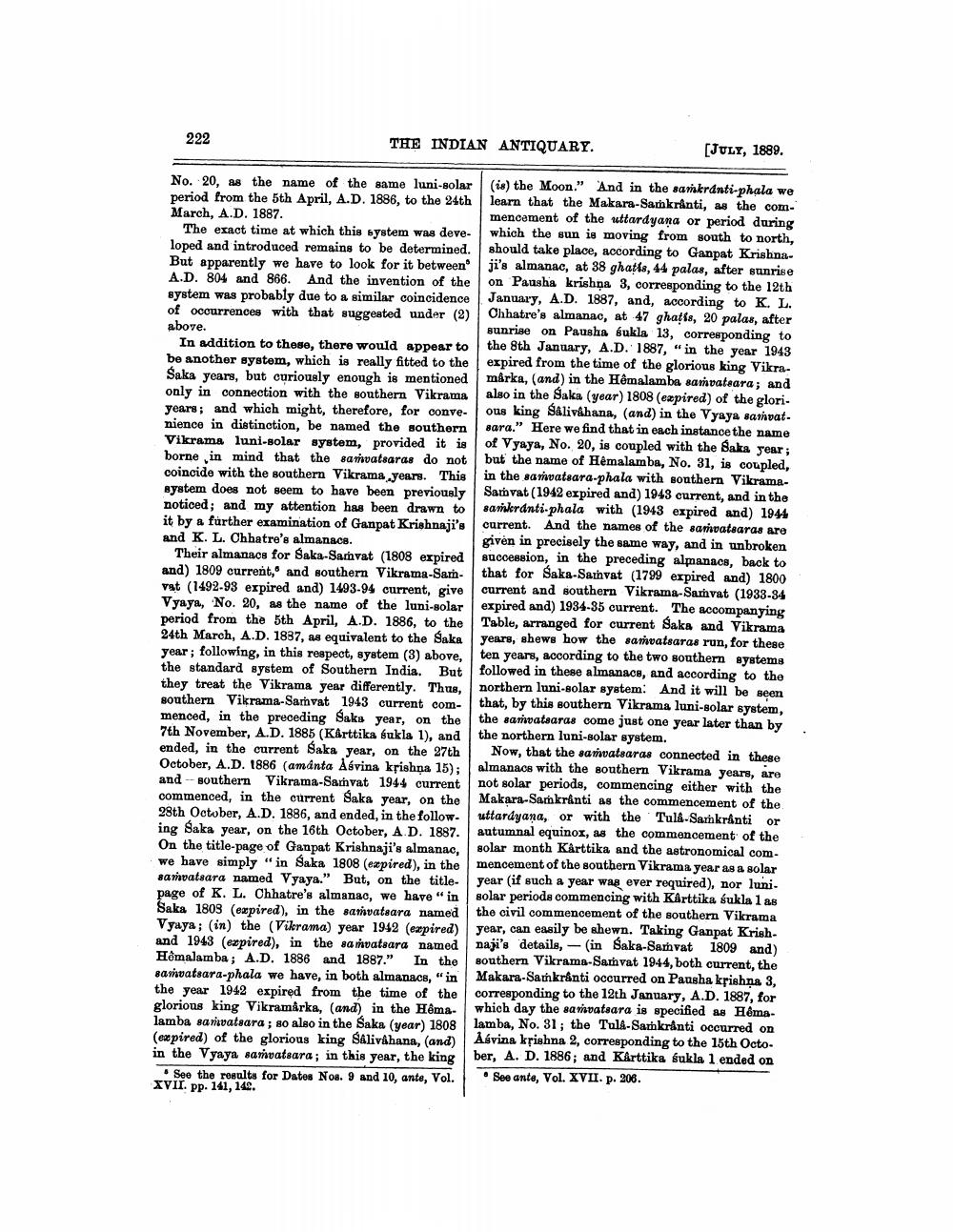________________
222
THE INDIAN ANTIQUARY.
No. 20, as the name of the same luni-solar period from the 5th April, A.D. 1886, to the 24th March, A.D. 1887.
The exact time at which this system was developed and introduced remains to be determined. But apparently we have to look for it between" A.D. 804 and 866. And the invention of the system was probably due to a similar coincidence of occurrences with that suggested under (2) above.
In addition to these, there would appear to be another system, which is really fitted to the Saka years, but curiously enough is mentioned only in connection with the southern Vikrama years; and which might, therefore, for convenience in distinction, be named the southern Vikrama luni-solar system, provided it is borne in mind that the samvatsaras do not coincide with the southern Vikrama,years. This system does not seem to have been previously noticed; and my attention has been drawn to it by a further examination of Ganpat Krishnaji's and K. L. Chhatre's almanacs.
[JULY, 1889.
(is) the Moon." And in the samkranti-phala we learn that the Makara-Samkrânti, as the com-" mencement of the uttardyana or period during which the sun is moving from south to north, should take place, according to Ganpat Krishnaji's almanac, at 38 ghatis, 44 palas, after sunrise on Pausha krishna 3, corresponding to the 12th January, A.D. 1887, and, according to K. L. Chhatre's almanac, at 47 ghatis, 20 palas, after sunrise on Pausha éukla 13, corresponding to the 8th January, A.D. 1887, "in the year 1943 expired from the time of the glorious king Vikramårka, (and) in the Hêmalamba samvatsara; and also in the Saka (year) 1808 (expired) of the glorious king Salivahana, (and) in the Vyaya samvatsara." Here we find that in each instance the name of Vyaya, No. 20, is coupled with the Saka year; but the name of Hêmalamba, No. 31, is coupled, in the samvatsara-phala with southern VikramaSamvat (1942 expired and) 1943 current, and in the samkrdnti-phala with (1943 expired and) 1944 current. And the names of the samvatsaras are given in precisely the same way, and in unbroken succession, in the preceding almanacs, back to that for Saka-Samvat (1799 expired and) 1800 current and southern Vikrama-Samvat (1933-34 expired and) 1934-35 current. The accompanying Table, arranged for current Saka and Vikrama years, shews how the samvatsaras run, for these ten years, according to the two southern systems followed in these almanacs, and according to the northern luni-solar system: And it will be seen that, by this southern Vikrama luni-solar system, the samvatsaras come just one year later than by the northern luni-solar system.
Now, that the samvatsaras connected in these almanacs with the southern Vikrama years, are not solar periods, commencing either with the Makara-Samkranti as the commencement of the
Their almanacs for Saka-Samvat (1808 expired and) 1809 current, and southern Vikrama-Samvat (1492-93 expired and) 1493-94 current, give Vyaya, No. 20, as the name of the luni-solar period from the 5th April, A.D. 1886, to the 24th March, A.D. 1887, as equivalent to the Saka year; following, in this respect, system (3) above, the standard system of Southern India. But they treat the Vikrama year differently. Thus, southern Vikrama-Samvat 1943 current commenced, in the preceding Saka year, on the 7th November, A.D. 1885 (Kârttika sukla 1), and ended, in the current Saka year, on the 27th October, A.D. 1886 (amânta Aévina krishna 15); and southern Vikrama-Samvat 1944 current commenced, in the current Saka year, on the 28th October, A.D. 1886, and ended, in the follow-uttardyana, or with the Tula-Samkrânti or ing Saka year, on the 16th October, A.D. 1887. autumnal equinox, as the commencement of the On the title-page of Ganpat Krishnaji's almanac, solar month Karttika and the astronomical comwe have simply "in Saka 1808 (expired), in the mencement of the southern Vikrama year as a solar samvatsara named Vyaya." But, on the title- year (if such a year was ever required), nor lunipage of K. L. Chhatre's almanac, we have "in solar periods commencing with Kârttika śukla 1 as Saka 1803 (expired), in the samvatsara named the civil commencement of the southern Vikrama Vyaya; (in) the (Vikrama) year 1942 (expired) year, can easily be shewn. Taking Ganpat Krishand 1943 (expired), in the samvatsara named naji's details, (in Saka-Samvat 1809 and) Hêmalamba; A.D. 1886 and 1887." In the southern Vikrama-Samvat 1944, both current, the samvatsara-phala we have, in both almanacs, "in Makara-Sankranti occurred on Pausha krishna 3, the year 1942 expired from the time of the corresponding to the 12th January, A.D. 1887, for glorious king Vikramárka, (and) in the Hêma- which day the samvatsara is specified as Hêmalamba samvatsara; so also in the Saka (year) 1808 lamba, No. 31; the Tula-Sankranti occurred on (expired) of the glorious king Salivahana, (and) Aévina krishna 2, corresponding to the 15th Octoin the Vyaya samvatsara; in this year, the king ber, A. D. 1886; and Kârttika sukla 1 ended on
See ante, Vol. XVII. p. 206.
See the results for Dates Nos. 9 and 10, ante, Vol. XVII. pp. 141, 142.




